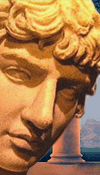





|
|
|
|
November 08, 2007
The unbearable whiteness of David
1527. Huh? Actually, 1527 is one of the most interesting (if underated) years in history. Rome was viciously sacked by a resentful brigand army nominally loyal to Charles V. Nicolo Machiavelli died dispirited in the same year. 1527 is considered to mark the end of the Roman Renaissance. And in what's little more than a footnote to history, the left arm of David was broken in what is often described as a riot. I'll begin with a poem I stumbled across titled "Goliath's Revenge." Marcus Rediker (a history professor whose views are far-left) expresses wishful sympathy with whoever broke the arm: Here is DavidThat statue must have been unbearably white. Especially to the motley mob of angry Florentine Republicans who sought to drive the Medicis from power. But did they really have a proletarian, anti-globalist view of things? Somehow, I doubt it. The spontaneity of the "riots" certainly seems debatable. According to most sources, whoever was behind them took deliberate advantage of the invading army of Charles V when it was on its way to the sacking of Rome: When Emperor Charles V sacked Rome in 1527, the Florentines took advantage of the turmoil in Italy to reinstall the Republic; both Alessandro and Ippolito fled, along with the rest of the Medici and their main supporters, including the Pope's regent, Cardinal Silvio Passerini, with the exception of the eight-year-old Caterina de' Medici, who was left behind. Michelangelo, then occupied in creating a funerary chapel for the Medici, initially took charge of building fortifications around Florence in support of the Republic; he later temporarily fled the city. Clement eventually made his peace with the Emperor, and with the support of Imperial troops, the Republic was overwhelmed after a lengthy siege, and the Medici were restored to power in the summer of 1530.It needs to be borne in mind that the Sack of Rome was especially brutal (the Medici Pope Clement VII wore an illegal beard in mourning for the rest of his life, starting a bearded papal trend), and who has ultimate responsibility is still very much in debate. Whether measured in human or cultural terms, the destruction was appalling: By the end of summer 1527, 45,000 Roman men, women, and children were gone, either fleeing as refugees or killed in the sack: no one has ever been able to determine the proportion of dead or missing. Rome's population hit rock bottom at about 10,000. Churches, shrines, monuments were looted and destroyed -- only the Sistine Chapel escaped because thatís where the Constable's body had been taken to lie in state. Contemporary witnesses were unanimous that the Catholic regular soldiers of Charles V as well as the Protestant mercenaries (and many local gang leaders -- i.e., the heads of the big families) had participated in the murder and looting.Reading the Wiki entry, it appears that the army was an interesting and undisciplined agglomeration, doubtless with conflicting loyalties: The army of the Holy Roman Emperor defeated the French army on Italy, but funds were not available to pay the soldiers. The 34,000 Imperial troops mutinied, and forced their commander, Charles III, Duke of Bourbon and Constable of France, to lead them towards Rome. Apart from some 6,000 Spaniards under the Duke, the army included some 14,000 Landsknechts under Georg von Frundsberg, some Italian infantry led by Fabrizio Maramaldo, Sciarra Colonna and Luigi Gonzaga, and some cavalry under Ferdinando Gonzaga and Philibert, Prince of Chalons. Though Martin Luther himself was not in favor of it, some who considered themselves followers of Luther viewed the Papal capital as a target for religious reasons, and shared with the soldiers an avaricious desire for the sacking and pillage of a city that appeared to be an easy target. Numerous bandits, along with the League's deserters, joined with the army during the march.No wonder Luther didn't want to be seen as taking responsibility for the actions of his followers. Considering what happened, I doubt anyone would. As to the artist himself, while he had carved David for the Medicis (who continued to sponsor him) he nonetheless aided in the defenses of Florence against the joint military invasion by the Medicis and the Vatican: During all the confusion, the republican element in Florence reasserted itself and re-established the Florentine Republic.I'm still having trouble seeing the statue in terms of whiteness theory or proletarian resistence, but then, I also had trouble seeing the same poet's linkage of guns to slavery (especially his implication of Smith & Wesson, manufacturer of guns which defeated the Confederacy). There isn't enough time in the day to deconstruct every last deconstructed morsel I see. And if it hadn't been for the Inquirer's review of Rediker's latest book, I'd have never read the man's poetry. It just so happened that a statement he made about slavery and capitalism drew me in: I offer this study with the greatest reverence for those who suffered almost unthinkable violence, terror and death, in the firm belief we must remember that such horrors have always been, and remain, central to the making of global capitalism.But lest anyone get the wrong idea about the Inquirer, the above review was hardly an exercise in capitalist bashing compared to that in the New York Times: Just as corporate officers now get stock options, slave-ship officers received the extra compensation of a few "privilege" slaves they were permitted to buy, transport and sell for their own profit. Sometimes there were executive bonuses tied directly to performance, based on the number of slaves delivered. And finally, those who succeeded in the business could seamlessly make the transition to politics, the way tycoons still do: former slave-ship captains sat in both the British House of Commons and the United States Senate (James D'Wolf of Rhode Island). This complex tissue of normality makes one wonder what aspects of our own everyday business-as-usual people will, a century or two from now, be considered as horrendous as we think the slave trade was.While we're at it, I'm thinking that capitalism might also be ultimately responsible for the 100 million or so said to have been "killed by Communism." Regrettable that any deaths might have been, weren't such "horrors" actually made necessary because of the brutality and evil nature of the forces of global capitalism? Is it really logical to blame those who were trying to defeat capitalism for the inevitable deaths which occurred during their struggle? It would make about as much sense to blame the Allies for the deaths of the Nazis as to blame the Communists for the deaths of their enemies. And how do we know that Goliath wasn't a brown-skinned resistance leader? posted by Eric on 11.08.07 at 08:39 AM |
|
June 2008
WORLD-WIDE CALENDAR
Search the Site
E-mail
Classics To Go
Archives
June 2008
May 2008 April 2008 March 2008 February 2008 January 2008 December 2007 November 2007 October 2007 September 2007 August 2007 July 2007 June 2007 May 2007 April 2007 March 2007 February 2007 January 2007 December 2006 November 2006 October 2006 September 2006 August 2006 July 2006 June 2006 May 2006 April 2006 March 2006 February 2006 January 2006 December 2005 November 2005 October 2005 September 2005 August 2005 July 2005 June 2005 May 2005 April 2005 March 2005 February 2005 January 2005 December 2004 November 2004 October 2004 September 2004 August 2004 July 2004 June 2004 May 2004 April 2004 March 2004 February 2004 January 2004 December 2003 November 2003 October 2003 September 2003 August 2003 July 2003 June 2003 May 2003 May 2002 AB 1634 MBAPBSALLAMERICANGOP See more archives here Old (Blogspot) archives
Recent Entries
• My ongoing inability to explain the difference between zero intolerance and zero tolerance
• And if you like hedonism? • Go Your Own Way • How green was my car! • We See Nothing • Feeling empathy for Genghis Khan • Please Yourself • Better Than Printing Money? • "you can't have him!" (unless.....) • No free speech for assholes!
Links
Site Credits
|
|
test